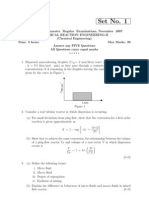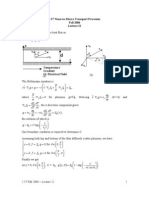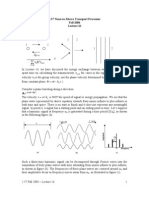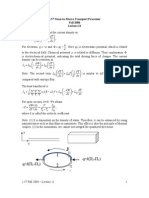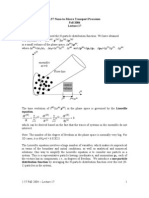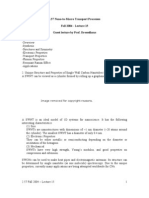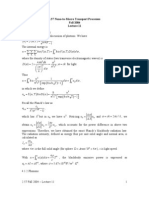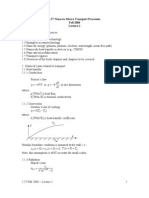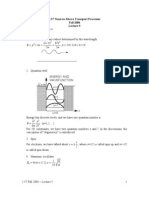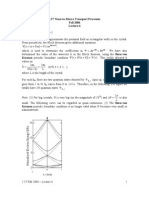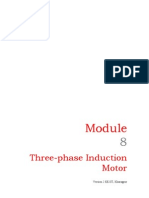Module 10: Solved Problems
Uploaded by
captainhassModule 10: Solved Problems
Uploaded by
captainhass1
MODULE 10: SOLVED PROBLEMS
Problem 1: A thin plastic membrane is used to separate Helium from a gas stream. Under state
conditions, the concentration of helium in the membrane is known to be 0.02 and 0.005 kmol/m3
at the inner and outer surfaces, respectively. If the membrane is 1 mm thick and the binary
diffusion coefficient of helium with respect to the plastic is 10-9 m3/s, what is the diffusion flux?
Solution:
Known: Molar concentrations of He at the inner and outer surfaces of a plastic membrane;
diffusion coefficient and membrane thickness.
To calculate: Molar diffusion flux
Schematic:
Assumptions: Steady state, 1D diffusion in a plane wall, stationary medium, uniform C = CA +
CB
Analysis: The molar flux may be obtained from
10−9 m 2 /s
N ′A′, x =
DAB
(C A,1 − C A,2 ) = (0.02 − 0.005) kmol/m3
L 0.001 m
N ′A′, x = 1.5 × 10−8 kmol/s.m2
2
Problem 2: Oxygen is maintained at pressures of 2 bars ans 1 bar on opposite sides of a rubber
membrane that is 0.5 mm thick, and the entire system is at 25 C. What is the molar diffusion flux
of O2 through the membrane? What are the molar concentrations of O2 on both sides of the
membrane (outside the rubber)?
Solution:
Known: Oxygen pressures on opposite sides of a rubber membrane.
To find: Molar diffusion flux of oxygen; Molar concentration of oxygen outside the rubber.
Schematic:
Assumptions: Steady state, 1D diffusion, stationary medium of uniform total molar
concentrations, C = CA + CB; perfect gas behaviour.
Properties given: Oxygen-rubber (298 K): DAB = 0.21 × 10-9 m2/s; S = 3.12 × 10-3 kmol/m3.bar.
Analysis:
(a) For the assumed conditions
dC A C ( 0) − C A ( L )
N ′A′, x = J ′A′, x = − DAB= DAB A
dx L
C A (0) = Sp A,1 = 6.24 × 10 kmol/m
−3 −3
C A ( L) = Sp A, 2 = 3.12 × 10 −3 kmol/m3
Hence:
(6.24 × 10 −3 − 3.12 × 10 −3 ) kmol/m3
N A′′, x = 0.21 × 10 m /s
−9 2
0.0005 m
N A′′, x = 1.31 × 10 −9 kmol/s.m2
(b) From the perfect gas law:
PA,1 2 bar
C A,1 = = 3
= 0.087 kmol/m3
RT (0.08314 m .bar/kmol.K
C A, 2 = 0.5C A,1 = 0.0404 kmol/m3
You might also like
- At RT P VBVVB: Calculate Z, GR, HR and SR For Co2 at 325 K and 60 Bar Using R-K Eos. AnswerNo ratings yetAt RT P VBVVB: Calculate Z, GR, HR and SR For Co2 at 325 K and 60 Bar Using R-K Eos. Answer2 pages
- Simulink Development of Single Effect Evaporator Using MatlabNo ratings yetSimulink Development of Single Effect Evaporator Using Matlab12 pages
- Natural Rubber Conversion To Limonene by Vacuum Pyrolysis in Presence of Solid Catalyst100% (1)Natural Rubber Conversion To Limonene by Vacuum Pyrolysis in Presence of Solid Catalyst113 pages
- Lab Report On Solid Liquid Equilibrium in A Binary SystemNo ratings yetLab Report On Solid Liquid Equilibrium in A Binary System7 pages
- UniMasr.com_2be31ab58f7cc25cb190196e659bc946100% (1)UniMasr.com_2be31ab58f7cc25cb190196e659bc94695 pages
- Chapter No.3 Material Balance: 3.1 Fluidized Bed ReactorNo ratings yetChapter No.3 Material Balance: 3.1 Fluidized Bed Reactor14 pages
- Comparison of Gas Absorption and Distillation Unit Operations100% (2)Comparison of Gas Absorption and Distillation Unit Operations2 pages
- Mass Transfer Operations (ENV 425) Problem Set 4: Zewail City of Science and TechnologyNo ratings yetMass Transfer Operations (ENV 425) Problem Set 4: Zewail City of Science and Technology3 pages
- Mass Transfer-2 (CLL-352) Tutorial #1: P1) Ammonia (A) Diffuses Through A Stagnant Layer of Air (B), 1cmNo ratings yetMass Transfer-2 (CLL-352) Tutorial #1: P1) Ammonia (A) Diffuses Through A Stagnant Layer of Air (B), 1cm1 page
- Experiment No: 6: Feed Tanks Batch ReactorNo ratings yetExperiment No: 6: Feed Tanks Batch Reactor5 pages
- BARKLEY and MOTARD-Decomposition of Nets, 1972No ratings yetBARKLEY and MOTARD-Decomposition of Nets, 197211 pages
- Process Development For The Production of 100 TPD Dimethylformamide Using Methanol Dehydrogenation Process S. Srinivasan, P. R. NarenNo ratings yetProcess Development For The Production of 100 TPD Dimethylformamide Using Methanol Dehydrogenation Process S. Srinivasan, P. R. Naren2 pages
- 3 ChE 32 Material Balance With Chemical Recations0% (1)3 ChE 32 Material Balance With Chemical Recations1 page
- Aspen Plus Example of CO2 Capture From Syngas For IGCC Using MEA - v12No ratings yetAspen Plus Example of CO2 Capture From Syngas For IGCC Using MEA - v128 pages
- Increasing Yield in The Manufacturing of MPDSA0% (2)Increasing Yield in The Manufacturing of MPDSA3 pages
- Steady-State Non-Isothermal Reactor DesignNo ratings yetSteady-State Non-Isothermal Reactor Design25 pages
- Dehydrogenation Process Description المشروعNo ratings yetDehydrogenation Process Description المشروع5 pages
- CL 333 Chemical Engineering Lab-2 (2019) : Experiment Number FM 302 TitleNo ratings yetCL 333 Chemical Engineering Lab-2 (2019) : Experiment Number FM 302 Title31 pages
- DSTWU - A Shortcut Distillation Model in Aspen Plus V8.0No ratings yetDSTWU - A Shortcut Distillation Model in Aspen Plus V8.011 pages
- Introductory Applications of Partial Differential Equations: With Emphasis on Wave Propagation and DiffusionFrom EverandIntroductory Applications of Partial Differential Equations: With Emphasis on Wave Propagation and DiffusionNo ratings yet
- Q FV V: 2.57 Nano-to-Macro Transport Processes Fall 2004No ratings yetQ FV V: 2.57 Nano-to-Macro Transport Processes Fall 20045 pages
- 2.57 Nano-to-Macro Transport Processes Fall 2004: I T KXNo ratings yet2.57 Nano-to-Macro Transport Processes Fall 2004: I T KX8 pages
- Q FV V: 2.57 Nano-to-Macro Transport Processes Fall 2004No ratings yetQ FV V: 2.57 Nano-to-Macro Transport Processes Fall 20047 pages
- 2.57 Nano-to-Macro Transport Processes Fall 2004 Guest Lecture by Prof. Mildred S. DresselhausNo ratings yet2.57 Nano-to-Macro Transport Processes Fall 2004 Guest Lecture by Prof. Mildred S. Dresselhaus10 pages
- 2.57 Nano-to-Macro Transport Processes Fall 2004No ratings yet2.57 Nano-to-Macro Transport Processes Fall 20049 pages
- d dT J Lq L dx dx: q=J (Π - Π) q=J (Π - Π)No ratings yetd dT J Lq L dx dx: q=J (Π - Π) q=J (Π - Π)6 pages
- 2.57 Nano-to-Macro Transport Processes Fall 2004: F M F F FNo ratings yet2.57 Nano-to-Macro Transport Processes Fall 2004: F M F F F5 pages
- 2.57 Nano-to-Macro Transport Processes Fall 2004:) N N N N (NNo ratings yet2.57 Nano-to-Macro Transport Processes Fall 2004:) N N N N (N8 pages
- 2.57 Nano-to-Macro Transport Processes Fall 2004 - Lecture 15 Guest Lecture by Prof. DresselhausNo ratings yet2.57 Nano-to-Macro Transport Processes Fall 2004 - Lecture 15 Guest Lecture by Prof. Dresselhaus10 pages
- N F T e U F T F TD D: 2.57 Nano-to-Macro Transport Processes Fall 2004No ratings yetN F T e U F T F TD D: 2.57 Nano-to-Macro Transport Processes Fall 20046 pages
- 2.57 Nano-to-Macro Transport Processes Fall 2004: Ae Be CeNo ratings yet2.57 Nano-to-Macro Transport Processes Fall 2004: Ae Be Ce7 pages
- 2.57 Nano-to-Macro Transport Processes Fall 2004: Nlms 2No ratings yet2.57 Nano-to-Macro Transport Processes Fall 2004: Nlms 27 pages
- 2.57 Nano-to-Macro Transport Processes Fall 2004: DT Q K T Q DX Q (W/M K (W/M-K) Is Thermal ConductivityNo ratings yet2.57 Nano-to-Macro Transport Processes Fall 2004: DT Q K T Q DX Q (W/M K (W/M-K) Is Thermal Conductivity5 pages
- 2.57 Nano-to-Macro Transport Processes Fall 2004: V L KK VKK N VNo ratings yet2.57 Nano-to-Macro Transport Processes Fall 2004: V L KK VKK N V7 pages
- 2.57 Nano-to-Macro Transport Processes Fall 2004: Ja (j-1) A (j+1) ANo ratings yet2.57 Nano-to-Macro Transport Processes Fall 2004: Ja (j-1) A (j+1) A9 pages
- 2.57 Nano-to-Macro Transport Processes Fall 2004: A Wigner-Seitz Primitive Unit CellNo ratings yet2.57 Nano-to-Macro Transport Processes Fall 2004: A Wigner-Seitz Primitive Unit Cell6 pages
- 2.57 Nano-to-Macro Transport Processes Fall 2004: E HN MNo ratings yet2.57 Nano-to-Macro Transport Processes Fall 2004: E HN M10 pages
- 2.57 Nano-to-Macro Transport Processes Fall 2004No ratings yet2.57 Nano-to-Macro Transport Processes Fall 20047 pages
- 2.57 Nano-To-Macro Transport Processes Fall 2004: Ikn A IkxNo ratings yet2.57 Nano-To-Macro Transport Processes Fall 2004: Ikn A Ikx7 pages
- 2.57 Nano-to-Macro Transport Processes Fall 2004No ratings yet2.57 Nano-to-Macro Transport Processes Fall 20047 pages
- 2.57 Nano-to-Macro Transport Processes Fall 2004No ratings yet2.57 Nano-to-Macro Transport Processes Fall 20046 pages
- 2.57 Nano-to-Macro Transport Processes Fall 2004No ratings yet2.57 Nano-to-Macro Transport Processes Fall 20048 pages
- Three-Phase Induction Motor: Version 2 EE IIT, KharagpurNo ratings yetThree-Phase Induction Motor: Version 2 EE IIT, Kharagpur8 pages
- Three-Phase Delta-Connected Balanced LoadNo ratings yetThree-Phase Delta-Connected Balanced Load12 pages
- Simulation Metalsinaqueoussolutions StudentNo ratings yetSimulation Metalsinaqueoussolutions Student9 pages
- 240-61227438 Eskom Network Planning Guide For Lines and CablesNo ratings yet240-61227438 Eskom Network Planning Guide For Lines and Cables75 pages
- A Spent Coffee Grounds Based Biorefinery For The Production of BiofuelsNo ratings yetA Spent Coffee Grounds Based Biorefinery For The Production of Biofuels15 pages
- Usg Shaft Wall Systems Catalog en SA926No ratings yetUsg Shaft Wall Systems Catalog en SA92644 pages
- Fosroc Nitocote EP410: Constructive SolutionsNo ratings yetFosroc Nitocote EP410: Constructive Solutions4 pages
- Overcoming Limitations of Vaporized Hydrogen Peroxide100% (1)Overcoming Limitations of Vaporized Hydrogen Peroxide8 pages
- Electropolished Tube - Electropolished Stainless Steel Tubing - Electropolish Tube - Rensa TubesNo ratings yetElectropolished Tube - Electropolished Stainless Steel Tubing - Electropolish Tube - Rensa Tubes13 pages
- Unit 01 Fundamentals of Machine Design (Question Bank)No ratings yetUnit 01 Fundamentals of Machine Design (Question Bank)2 pages










































